With her round apple face, big eyes and charm, French-born Hollywood star Claudette Colbert (1903-1996) was the epitome of chic sophistication. Her comedies It Happened One Night (1934) - for which she won the Oscar, Midnight (1939) and The Palm Beach Story (1942) are among Hollywood's greatest ever. After more than 60 films, she returned with great success to the theatre and was 84 years old when she won a Golden Globe for the TV mini-series The Two Mrs. Grenvilles (1987).
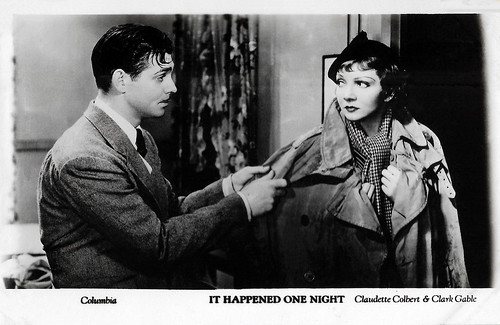
British postcard in the Film Shots Series by Film Weekly. Photo: Columbia. Clark Gable and Claudette Colbert in It Happened One Night (Frank Capra, 1934).

French postcard by Europe, no. 52. Photo: Paramount. Claudette Colbert in His Woman (Edward Sloman, 1931).

Dutch postcard, no. 132. Photo: Paramount. Maurice Chevalier and Claudette Colbert In The Smiling Lieutenant (Ernst Lubitsch, 1931).

Dutch-German postcard by Ross Verlag, no. 176/2. Photo: Paramount. Claudette Colbert as the Empress Poppaea in The Sign of the Cross (Cecil B. DeMille, 1932).
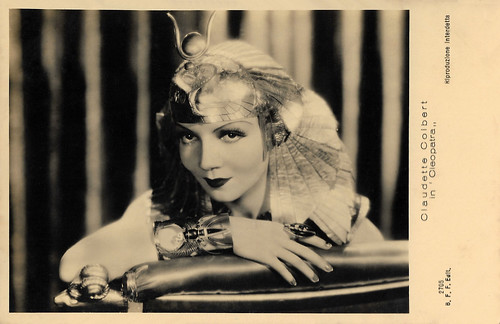
Italian postcard by B.F.F. Edit., no. 2705. Photo: Paramount. Claudette Colbert in Cleopatra (Cecil B. DeMille, 1934).
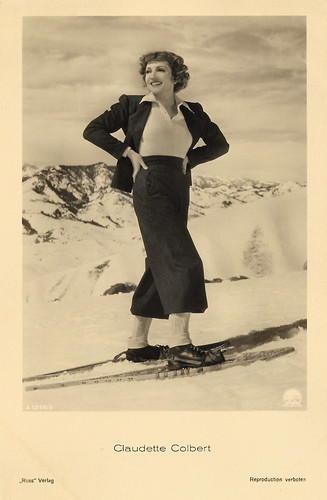
German postcard by Ross Verlag, no. A 1268/2, 1937-1938. Photo: Paramount. Publicity still for I Met Him in Paris (Wesley Ruggles, 1937).

Dutch postcard by Takken / 't Sticht, no. 3088. Photo: R.K.O. Radio Films. Claudette Colbert in Without Reservations (Mervyn LeRoy, 1946).
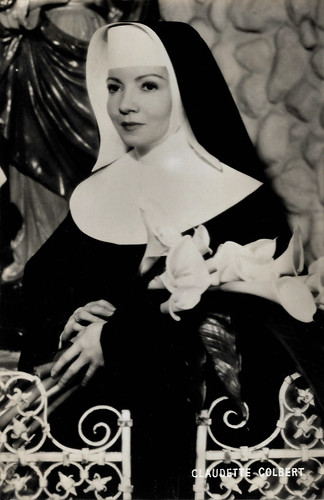
Vintage postcard, no. 12. Claudette Colbert in Thunder on the Hill (Douglas Sirk, 1951).
Claudette Colbert was born Emilie ‘Lily’ Claudette Chauchoin in 1903 in Saint-Mandé, an eastern suburb of Paris, where her father owned a bakery. Her parents were Georges Claude Chauchoin and Jeanne Marie née Loew. In 1906 her family emigrated to New York. Though she did some acting in college, her primary interest was fashion design. She studied fashion when she met the writer Anne Morrison at a party who offered the 20-year-old student a small role in her play The Wild Westcotts (1923) on Broadway. She started to use the stage name, Claudette Colbert.
British actor Leslie Howard, with whom she had a brief relationship in 1924, encouraged her and persuaded his friend the producer Al Woods to put her under contract. After signing a five-year contract with Woods, Colbert played ingenue roles on Broadway from 1925 through 1929. Despite personally good notices, she did not get into a major hit until The Barker (1927) with Walter Huston and Norman Foster. In The Barker, she played a duplicitous snake charmer. She and Foster, later a Hollywood actor and director, were married the following year during the play's London run. Their marriage remained a secret for many years while they lived in separate homes. In Los Angeles, Colbert shared a home with her mother Jeanne Chauchoin, but her domineering mother disliked Foster and did not allow him into their home. Colbert and Foster divorced in 1935 in Mexico.
Colbert's first film, For the Love of Mike (Frank Capra, 1927), was made during The Barker's Broadway run. The silent film is now believed to be lost. She was concerned that silent cinema failed to utilise her melodious voice, one of her greatest assets. The advent of talkies changed her attitude, and in 1929 she signed a Paramount contract. Only two of her first 15 films - The Big Pond (Hobart Henley, 1930) and The Smiling Lieutenant (Ernst Lubitsch, 1931), both co-starring Maurice Chevalier - were better than mediocre. Then Cecil B. DeMille asked her to play Nero (Charles Laughton)'s unscrupulous wife Poppaea in the Biblical epic The Sign of the Cross (1932). Her performance was acclaimed, while her bath in donkey's milk received immense publicity and has become a famous scene in Hollywood history.
Columbia offered her the role of a spoiled heiress in It Happened One Night (Frank Capra, 1934). Colbert was initially reluctant to appear in the screwball comedy and demanded to be paid $50,000 - twice her usual pay - and that filming was to be completed within four weeks to allow her to take a planned vacation. Tom Valance in The Independent: “The role gave her the chance to work with Clark Gable, who had been forced by his studio, MGM, to do the film. Neither star initially expected much of the low-budget comedy which won five Oscars. Colbert was in fact boarding a train for New York on the night of the ceremony when she was stopped and rushed back to accept her Best Actress award from Shirley Temple.”
The madcap comedy was a mega-hit all across the country. Two more big hits consolidated her status. She played the title role in the lavish but inaccurate Cleopatra (Cecil B. De Mille, 1934). Then she starred in Imitation of Life (John Stahl, 1934), a trenchant study of racial intolerance. It was based on Fannie Hurst's novel about a young widow who becomes a millionaire marketing the pancake recipe of her black friend (Louise Beavers). While the widow and her daughter move into society, the friend insists on keeping in the background, and when her light-skinned daughter, who faces exclusion and prejudice where her counterpart has privilege and opportunity, tries to pass for white and disowns her mother, tragedy follows.
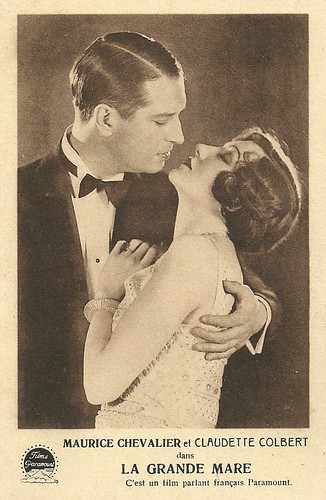
French postcard. Photo: Paramount. Maurice Chevalier and Claudette Colbert in the romantic comedy La grande mare (Hobart Henley, 1930), the French language version of The Big Pond (Hobart Henley, 1930).
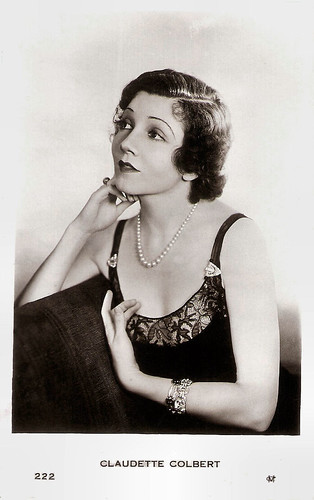
Spanish postcard by CM, no. 222.

Dutch-German postcard by Ross Verlag, no. 176/4. Photo: Paramount. Publicity still for Sign of the Cross (Cecil B. DeMille, 1932). Claudette Colbert as Empress Poppaea, bathing in donkey milk. On the back: Boekhandel Leonard Tijssen, Leeuwarden.

British postcard in the Filmshots series by Film Weekly. Photo: Paramount. Fredric March and Claudette Colbert in Tonight is Ours (Stuart Walker, 1933).

British postcard by Film Weekly. Photo: United Artists. Claudette Colbert and Ernest Torrence in I Cover the Waterfront (James Cruze, 1933).

French postcard by A.N., Paris, no. 962. Photo: Paramount. Publicity still for Cleopatra (Cecil B. DeMille, 1934) with Henry Wilcoxon.

Italian postcard by Consorzio Cinematografico E.I.A., print by Istituto Romano di Arti Grafiche di Tumminelli & C., Roma. Photo: Columbia. Claudette Colbert in It Happened One Night (Frank Capra, 1934), released in Italy as Accadde una notte. Caption: Superproduction Columbia, awarded at the Biennale of Venice as best comedy.
In 1935, Claudette Colbert was named one of the top 10 money-making stars, a position she was to hold again in 1936 and 1947. Fred MacMurray had his first major role in her next film, The Gilded Lily (Wesley Ruggles, 1935), and the two would go on to co-star in six more films. Charles Boyer, co-star of Colbert's next film, Private Worlds (Gregory La Cava, 1935), and not yet fully conversant with the English language, would also acknowledge the support he received from the actress, who won a second Oscar nomination for her performance as a psychiatrist in this grim story of mental illness.
Wikipedia: “Colbert was a stickler for perfection regarding the way she appeared on screen. She believed that her face was difficult to light and photograph, and was obsessed with not showing the right side of her face to the camera, because of a small bump resulting from a childhood broken nose. She often refused to be filmed from the right side of her face, and this sometimes necessitated redesigning movie sets.” Colbert's first marriage ended in 1935 while she was making She Married Her Boss (Gregory La Cava, 1935). The same year she married Joel Pressman, a throat specialist and surgeon at UCLA, who remained her husband until he died in 1968.
Colbert's role in Under Two Flags (Frank Lloyd, 1936), based on Ouida's tale of the Foreign Legion, was an unusual one for her, that of the tempestuous camp-follower 'Cigarette' who sacrifices herself for the love of a soldier (Ronald Colman). For the same director, she starred in Maid of Salem (Frank Lloyd, 1937), an account of the 1692 witch-hunts in Massachusetts. Colbert never seemed entirely comfortable in period pieces, and both audiences and critics were happy when she returned to modern comedy with I Met Him In Paris (Wesley Ruggles, 1937) and Tovarich (Anatole Litvak, 1937), in which she and Charles Boyer were impoverished Russian nobility working as maid and butler in a Parisian household.
Bluebeard's Eighth Wife (Ernst Lubitsch, 1938) had a screenplay by Billy Wilder and Charles Brackett, based on a 1923 Gloria Swanson silent film, but it was a disappointment. After a promising start in which Colbert meets Gary Cooper in a Riviera store where she is trying to buy pyjama bottoms while he is trying to purchase just the tops, it becomes contrived and frantic rather than funny. Zaza (George Cukor, 1939), in which Colbert sang several songs as a French music-hall star, was another failure.
Then followed one of her greatest films, the Cinderella-inspired screwball comedy Midnight (1939), directed by Mitchell Leisen and brilliantly written by Billy Wilder and Charles Brackett. Colbert next appeared with Henry Fonda in the Western Drums Along the Mohawk (John Ford, 1939), her first film in colour, as a farmer's wife coping with rugged conditions and hostile Indians. Boom Town (Jack Conway, 1940) was one of her most popular films, due to its star-power of Clark Gable, Spencer Tracy, Hedy Lamarr and Colbert.

Italian postcard by Rizzoli, Milano, 1937. Photo: Columbia.
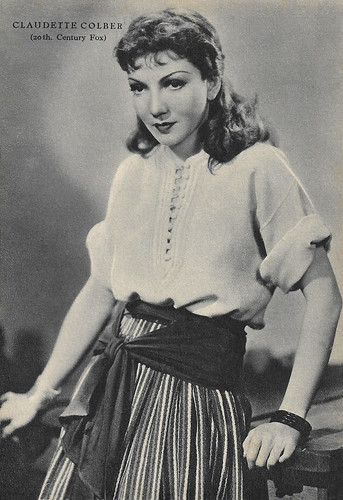
Italian postcard by Rizzoli & C. Milano, 1938. Photo: 20th Century Fox. Claudette Colbert in Under Two Flags (Frank Lloyd, 1936).
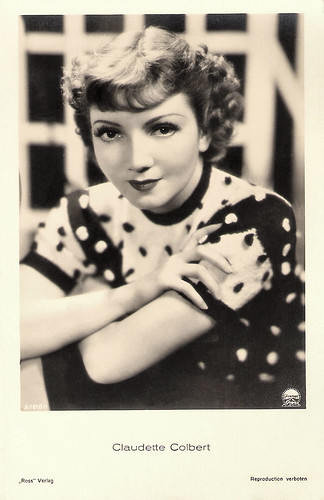
German postcard by Ross Verlag, no. A 1018/1, 1937-1938. Photo: Paramount.
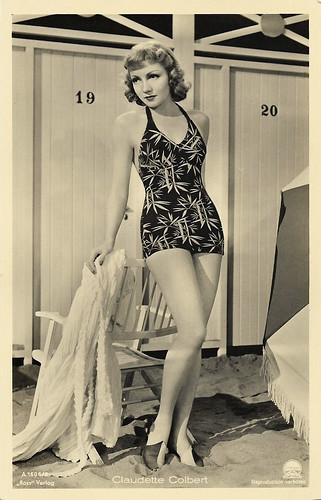
German postcard by Ross Verlag, no. 1606/2, 1937-1938. Photo: Paramount. Publicity still for Bluebeard's Eighth Wife (Ernst Lubitsch, 1938).
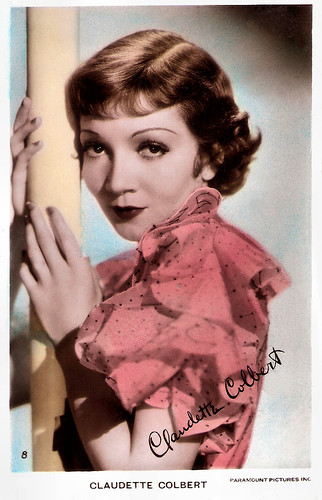
British postcard by Art Photo, no. 8. Photo: Paramount Pictures Inc.
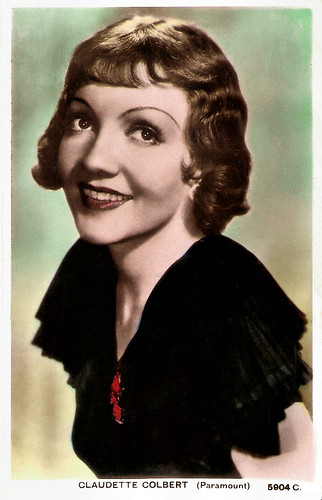
British postcard by Valentine's, no. 5904C. Photo: Paramount.
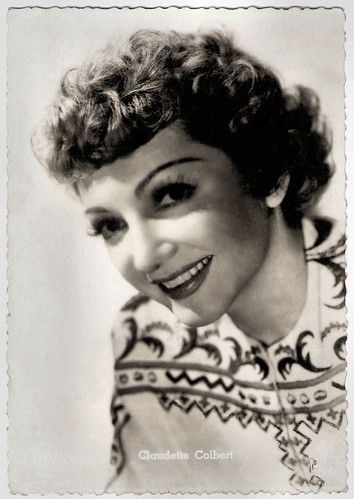
Belgian postcard by Les Editions d'Art L.A.B., Bruxelles, no. 1032. Photo: Metro-Goldwyn-Mayer. Publicity still for Boom Town (Jack Conway, 1940).
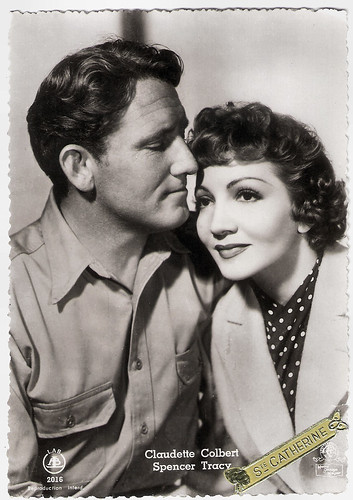
Belgian postcard by Les Editions d'Art L.A.B., Bruxelles, no. 2016. Photo: MGM. Publicity still for Boom Town (Jack Conway, 1940) with Spencer Tracy.
Claudette Colbert cited as her own favourite film Arise My Love (Mitchell Leisen, 1940), set just after the Spanish Civil War. Tom Valance in The Independent: “It has some splendidly romantic, dramatic and comic moments as Colbert, playing a reporter, pretends to be the wife of a condemned soldier of fortune (Ray Milland) to save him from a Spanish firing squad, then inevitably falls in love with him. Brackett and Wilder's screenplay tried to keep pace with changing events in Europe (the story ends after the invasion of France) which resulted in some uneasy shifts of mood in an otherwise impressive work.” Better still was Henry King's warmly charming piece of Americana Remember The Day (Henry King, 1941), in which Colbert gave a glowing performance as a school teacher who while visiting a now-famous former pupil recalls the past and her sweetheart who was killed in the First World War. Preston Sturges' The Palm Beach Story (1942) is one of the screen's greatest screwball comedies and contains the sequence Colbert later cited as her favourite comic scene. Having left her husband to find a millionaire to finance his inventions, she is climbing into a train's upper berth when she steps on the face and glasses of a rich passenger (Rudy Vallee).
During the Second World War, Colbert's husband, Joel Pressman, became a Navy lieutenant and she spent much time selling war bonds and working for the war effort. Two of her major films were effective wartime propaganda: So Proudly We Hail (Mark Sandrich, 1943), a tribute to the nurses in Bataan, and Since You Went Away (John Cromwell, 1944), producer David O. Selznick's ambitious three-hour tribute to the families at home. Colbert considered hard before taking the role of the mother to two teenage girls, but it became one of her finest, most deeply felt performances, representing the women left to raise families while their husbands are at war. In one remarkably touching scene Colbert, who has taken a job at a munitions factory, converses with a refugee, now a naturalised American (Alla Nazimova). For the part, she received her third Academy Award nomination but lost to Ingrid Bergman in Gaslight (George Cukor, 1944).
She appeared in such mild comedies as Practically Yours (Mitchell Leisen, 1944), and tepid dramas as Tomorrow is Forever (Irving Pichel, 1946) with Orson Welles. Colbert and Fred MacMurray had an enormous box-office hit with The Egg and I (Chester Erskine, 1947) as a city couple trying to run a farm, but the slapstick (lots of falling about in the mud) was far from the sophistication Colbert purveyed so expertly. Three Came Home (Jean Negulesco, 1950) gave her a strong dramatic role as Agnes Newton Keith, a true-life American author captured when the Japanese invaded Borneo in 1941. Her scenes with Sessue Hayakawa as the cultured prison camp commander were memorable in a gripping film which was too grim to be a major hit. Colbert had appeared on radio regularly throughout her career, and in 1951 she made her television debut on The Jack Benny Show. Other appearances included The Royal Family of Broadway (1954), The Guardsman (1955) and Blithe Spirit (1956), with Noel Coward and Lauren Bacall. In 1951 she also returned to the stage, with a tour of Noel Coward's Island Fling (later known as South Sea Bubble).
She went to Britain to star with Jack Hawkins in The Planter's Wife (Ken Annakin, 1952) based on the native terrorism being faced by rubber planters. The film was a hit in Britain. The following year Colbert went to France to play a mistress of Louis XIV in Sacha Guitry's lavish Si Versailles m'était conté/Royal Affairs in Versailles (1953). She returned to Broadway in 1955, replacing Margaret Sullavan in Janus, then in 1958 starred in a new play, Leslie Stevens's The Marriage-Go-Round. The play was a hit and Colbert won a Tony nomination. Her last film was Parrish (Delmer Daves, 1961), a soap opera in which Colbert played the mother of Troy Donahue. She continued to make Broadway appearances, among them The Irregular Verb To Love (1963), The Kingfisher (1978) and A Talent For Murder (1981), and she returned to the London stage in Frederick Lonsdale's Aren't We All? (1984) opposite Rex Harrison. For her television work in the mini-series The Two Mrs. Grenvilles (John Erman, 1987) she received a Golden Globe and a nomination for an Emmy Award.
Claudette Colbert spent much of her time at the 200-year-old plantation house she and her husband had bought long ago in Barbados, and she also had a flat in Paris and an apartment on the East Side of New York. After three strokes, she died in Barbados in 1996 at the age of 92. Tom Vallance in The Independent: “It is no accident, surely, that she flourished at that most European of studios, Paramount, home of Lubitsch and Chevalier, Mamoulian, Von Sternberg and Wilder. Her distinctive high-cheekboned beauty and the throaty individuality of her voice were complemented by superb comic timing and fine technical skill honed by an extensive apprenticeship in the theatre. She could be warmly compassionate in romantic drama but was unsurpassable in sophisticated comedy.”

Vintage card. Photo: Universal
.
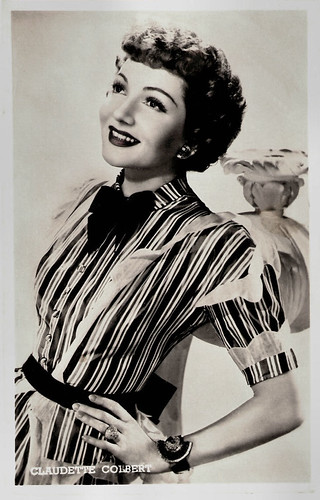
Dutch postcard by J.S.A. Photo: Columbia. Publicity still for Tomorrow is Forever (Irving Pichel, 1946).

Vintage postcard, no. 3401. Photo: R.K.O. Claudette Colbert in Without Reservations (Mervyn LeRoy, 1946).
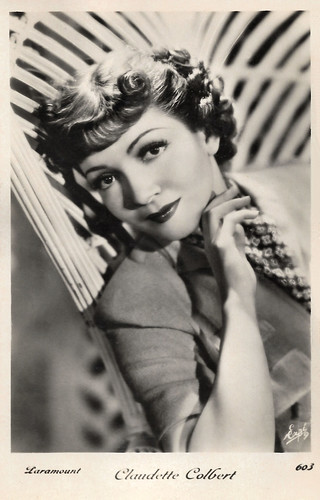
French postcard by Erpé, no. 603. Photo: Paramount.
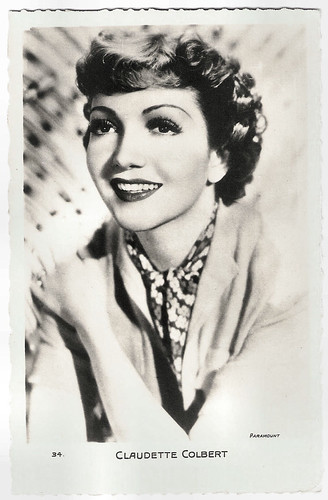
French postcard by Editions Chantal, Rueil-Malmaison, no. 34. Photo: Paramount.
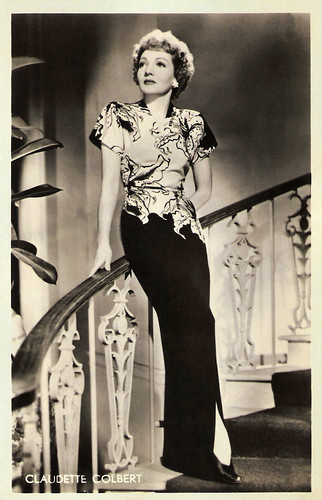
Dutch postcard by S. & v. H., A. Photo: M.P.E.A.
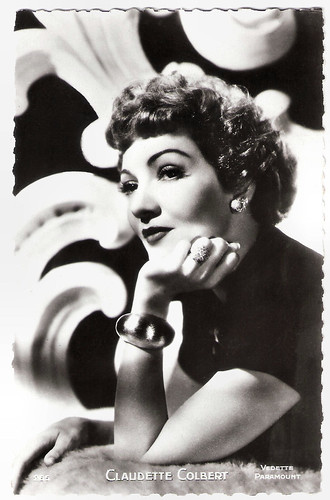
French postcard by Editions P.I., Paris, no. 265. Photo: Paramount.
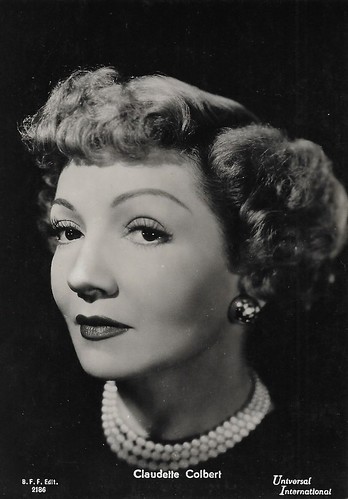
Italian postcard by B.F.F. Edit. (Ballerini & Fratini, Firenze, Editori), no. 2186. Photo: Universal International.
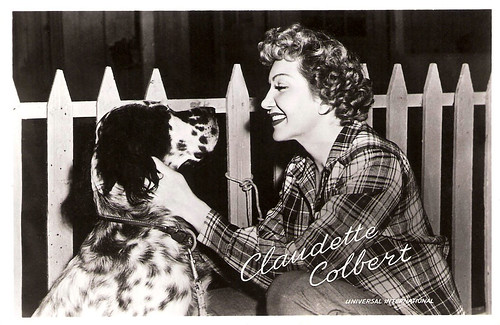
Dutch postcard by Takken, Utrecht. Photo: Universal International.

French postcard by Edition a la Carte. Photo: Filmhistorisches Bildarchiv Peter W. Engelmeier. Claudette Colbert and Clark Gable in It Happened One Night (Frank Capra, 1933).
Sources: Tom Vallance (The Independent), Hal Erickson (AllMovie), Denny Jackson (IMDb), Wikipedia and IMDb

British postcard in the Film Shots Series by Film Weekly. Photo: Columbia. Clark Gable and Claudette Colbert in It Happened One Night (Frank Capra, 1934).

French postcard by Europe, no. 52. Photo: Paramount. Claudette Colbert in His Woman (Edward Sloman, 1931).

Dutch postcard, no. 132. Photo: Paramount. Maurice Chevalier and Claudette Colbert In The Smiling Lieutenant (Ernst Lubitsch, 1931).

Dutch-German postcard by Ross Verlag, no. 176/2. Photo: Paramount. Claudette Colbert as the Empress Poppaea in The Sign of the Cross (Cecil B. DeMille, 1932).

Italian postcard by B.F.F. Edit., no. 2705. Photo: Paramount. Claudette Colbert in Cleopatra (Cecil B. DeMille, 1934).

German postcard by Ross Verlag, no. A 1268/2, 1937-1938. Photo: Paramount. Publicity still for I Met Him in Paris (Wesley Ruggles, 1937).

Dutch postcard by Takken / 't Sticht, no. 3088. Photo: R.K.O. Radio Films. Claudette Colbert in Without Reservations (Mervyn LeRoy, 1946).

Vintage postcard, no. 12. Claudette Colbert in Thunder on the Hill (Douglas Sirk, 1951).
Playing a duplicitous snake charmer
Claudette Colbert was born Emilie ‘Lily’ Claudette Chauchoin in 1903 in Saint-Mandé, an eastern suburb of Paris, where her father owned a bakery. Her parents were Georges Claude Chauchoin and Jeanne Marie née Loew. In 1906 her family emigrated to New York. Though she did some acting in college, her primary interest was fashion design. She studied fashion when she met the writer Anne Morrison at a party who offered the 20-year-old student a small role in her play The Wild Westcotts (1923) on Broadway. She started to use the stage name, Claudette Colbert.
British actor Leslie Howard, with whom she had a brief relationship in 1924, encouraged her and persuaded his friend the producer Al Woods to put her under contract. After signing a five-year contract with Woods, Colbert played ingenue roles on Broadway from 1925 through 1929. Despite personally good notices, she did not get into a major hit until The Barker (1927) with Walter Huston and Norman Foster. In The Barker, she played a duplicitous snake charmer. She and Foster, later a Hollywood actor and director, were married the following year during the play's London run. Their marriage remained a secret for many years while they lived in separate homes. In Los Angeles, Colbert shared a home with her mother Jeanne Chauchoin, but her domineering mother disliked Foster and did not allow him into their home. Colbert and Foster divorced in 1935 in Mexico.
Colbert's first film, For the Love of Mike (Frank Capra, 1927), was made during The Barker's Broadway run. The silent film is now believed to be lost. She was concerned that silent cinema failed to utilise her melodious voice, one of her greatest assets. The advent of talkies changed her attitude, and in 1929 she signed a Paramount contract. Only two of her first 15 films - The Big Pond (Hobart Henley, 1930) and The Smiling Lieutenant (Ernst Lubitsch, 1931), both co-starring Maurice Chevalier - were better than mediocre. Then Cecil B. DeMille asked her to play Nero (Charles Laughton)'s unscrupulous wife Poppaea in the Biblical epic The Sign of the Cross (1932). Her performance was acclaimed, while her bath in donkey's milk received immense publicity and has become a famous scene in Hollywood history.
Columbia offered her the role of a spoiled heiress in It Happened One Night (Frank Capra, 1934). Colbert was initially reluctant to appear in the screwball comedy and demanded to be paid $50,000 - twice her usual pay - and that filming was to be completed within four weeks to allow her to take a planned vacation. Tom Valance in The Independent: “The role gave her the chance to work with Clark Gable, who had been forced by his studio, MGM, to do the film. Neither star initially expected much of the low-budget comedy which won five Oscars. Colbert was in fact boarding a train for New York on the night of the ceremony when she was stopped and rushed back to accept her Best Actress award from Shirley Temple.”
The madcap comedy was a mega-hit all across the country. Two more big hits consolidated her status. She played the title role in the lavish but inaccurate Cleopatra (Cecil B. De Mille, 1934). Then she starred in Imitation of Life (John Stahl, 1934), a trenchant study of racial intolerance. It was based on Fannie Hurst's novel about a young widow who becomes a millionaire marketing the pancake recipe of her black friend (Louise Beavers). While the widow and her daughter move into society, the friend insists on keeping in the background, and when her light-skinned daughter, who faces exclusion and prejudice where her counterpart has privilege and opportunity, tries to pass for white and disowns her mother, tragedy follows.

French postcard. Photo: Paramount. Maurice Chevalier and Claudette Colbert in the romantic comedy La grande mare (Hobart Henley, 1930), the French language version of The Big Pond (Hobart Henley, 1930).

Spanish postcard by CM, no. 222.

Dutch-German postcard by Ross Verlag, no. 176/4. Photo: Paramount. Publicity still for Sign of the Cross (Cecil B. DeMille, 1932). Claudette Colbert as Empress Poppaea, bathing in donkey milk. On the back: Boekhandel Leonard Tijssen, Leeuwarden.

British postcard in the Filmshots series by Film Weekly. Photo: Paramount. Fredric March and Claudette Colbert in Tonight is Ours (Stuart Walker, 1933).

British postcard by Film Weekly. Photo: United Artists. Claudette Colbert and Ernest Torrence in I Cover the Waterfront (James Cruze, 1933).

French postcard by A.N., Paris, no. 962. Photo: Paramount. Publicity still for Cleopatra (Cecil B. DeMille, 1934) with Henry Wilcoxon.

Italian postcard by Consorzio Cinematografico E.I.A., print by Istituto Romano di Arti Grafiche di Tumminelli & C., Roma. Photo: Columbia. Claudette Colbert in It Happened One Night (Frank Capra, 1934), released in Italy as Accadde una notte. Caption: Superproduction Columbia, awarded at the Biennale of Venice as best comedy.
One of the top 10 money-making stars of 1935, 1936 and 1947
In 1935, Claudette Colbert was named one of the top 10 money-making stars, a position she was to hold again in 1936 and 1947. Fred MacMurray had his first major role in her next film, The Gilded Lily (Wesley Ruggles, 1935), and the two would go on to co-star in six more films. Charles Boyer, co-star of Colbert's next film, Private Worlds (Gregory La Cava, 1935), and not yet fully conversant with the English language, would also acknowledge the support he received from the actress, who won a second Oscar nomination for her performance as a psychiatrist in this grim story of mental illness.
Wikipedia: “Colbert was a stickler for perfection regarding the way she appeared on screen. She believed that her face was difficult to light and photograph, and was obsessed with not showing the right side of her face to the camera, because of a small bump resulting from a childhood broken nose. She often refused to be filmed from the right side of her face, and this sometimes necessitated redesigning movie sets.” Colbert's first marriage ended in 1935 while she was making She Married Her Boss (Gregory La Cava, 1935). The same year she married Joel Pressman, a throat specialist and surgeon at UCLA, who remained her husband until he died in 1968.
Colbert's role in Under Two Flags (Frank Lloyd, 1936), based on Ouida's tale of the Foreign Legion, was an unusual one for her, that of the tempestuous camp-follower 'Cigarette' who sacrifices herself for the love of a soldier (Ronald Colman). For the same director, she starred in Maid of Salem (Frank Lloyd, 1937), an account of the 1692 witch-hunts in Massachusetts. Colbert never seemed entirely comfortable in period pieces, and both audiences and critics were happy when she returned to modern comedy with I Met Him In Paris (Wesley Ruggles, 1937) and Tovarich (Anatole Litvak, 1937), in which she and Charles Boyer were impoverished Russian nobility working as maid and butler in a Parisian household.
Bluebeard's Eighth Wife (Ernst Lubitsch, 1938) had a screenplay by Billy Wilder and Charles Brackett, based on a 1923 Gloria Swanson silent film, but it was a disappointment. After a promising start in which Colbert meets Gary Cooper in a Riviera store where she is trying to buy pyjama bottoms while he is trying to purchase just the tops, it becomes contrived and frantic rather than funny. Zaza (George Cukor, 1939), in which Colbert sang several songs as a French music-hall star, was another failure.
Then followed one of her greatest films, the Cinderella-inspired screwball comedy Midnight (1939), directed by Mitchell Leisen and brilliantly written by Billy Wilder and Charles Brackett. Colbert next appeared with Henry Fonda in the Western Drums Along the Mohawk (John Ford, 1939), her first film in colour, as a farmer's wife coping with rugged conditions and hostile Indians. Boom Town (Jack Conway, 1940) was one of her most popular films, due to its star-power of Clark Gable, Spencer Tracy, Hedy Lamarr and Colbert.

Italian postcard by Rizzoli, Milano, 1937. Photo: Columbia.

Italian postcard by Rizzoli & C. Milano, 1938. Photo: 20th Century Fox. Claudette Colbert in Under Two Flags (Frank Lloyd, 1936).

German postcard by Ross Verlag, no. A 1018/1, 1937-1938. Photo: Paramount.

German postcard by Ross Verlag, no. 1606/2, 1937-1938. Photo: Paramount. Publicity still for Bluebeard's Eighth Wife (Ernst Lubitsch, 1938).

British postcard by Art Photo, no. 8. Photo: Paramount Pictures Inc.

British postcard by Valentine's, no. 5904C. Photo: Paramount.

Belgian postcard by Les Editions d'Art L.A.B., Bruxelles, no. 1032. Photo: Metro-Goldwyn-Mayer. Publicity still for Boom Town (Jack Conway, 1940).

Belgian postcard by Les Editions d'Art L.A.B., Bruxelles, no. 2016. Photo: MGM. Publicity still for Boom Town (Jack Conway, 1940) with Spencer Tracy.
A warmly charming piece of Americana
Claudette Colbert cited as her own favourite film Arise My Love (Mitchell Leisen, 1940), set just after the Spanish Civil War. Tom Valance in The Independent: “It has some splendidly romantic, dramatic and comic moments as Colbert, playing a reporter, pretends to be the wife of a condemned soldier of fortune (Ray Milland) to save him from a Spanish firing squad, then inevitably falls in love with him. Brackett and Wilder's screenplay tried to keep pace with changing events in Europe (the story ends after the invasion of France) which resulted in some uneasy shifts of mood in an otherwise impressive work.” Better still was Henry King's warmly charming piece of Americana Remember The Day (Henry King, 1941), in which Colbert gave a glowing performance as a school teacher who while visiting a now-famous former pupil recalls the past and her sweetheart who was killed in the First World War. Preston Sturges' The Palm Beach Story (1942) is one of the screen's greatest screwball comedies and contains the sequence Colbert later cited as her favourite comic scene. Having left her husband to find a millionaire to finance his inventions, she is climbing into a train's upper berth when she steps on the face and glasses of a rich passenger (Rudy Vallee).
During the Second World War, Colbert's husband, Joel Pressman, became a Navy lieutenant and she spent much time selling war bonds and working for the war effort. Two of her major films were effective wartime propaganda: So Proudly We Hail (Mark Sandrich, 1943), a tribute to the nurses in Bataan, and Since You Went Away (John Cromwell, 1944), producer David O. Selznick's ambitious three-hour tribute to the families at home. Colbert considered hard before taking the role of the mother to two teenage girls, but it became one of her finest, most deeply felt performances, representing the women left to raise families while their husbands are at war. In one remarkably touching scene Colbert, who has taken a job at a munitions factory, converses with a refugee, now a naturalised American (Alla Nazimova). For the part, she received her third Academy Award nomination but lost to Ingrid Bergman in Gaslight (George Cukor, 1944).
She appeared in such mild comedies as Practically Yours (Mitchell Leisen, 1944), and tepid dramas as Tomorrow is Forever (Irving Pichel, 1946) with Orson Welles. Colbert and Fred MacMurray had an enormous box-office hit with The Egg and I (Chester Erskine, 1947) as a city couple trying to run a farm, but the slapstick (lots of falling about in the mud) was far from the sophistication Colbert purveyed so expertly. Three Came Home (Jean Negulesco, 1950) gave her a strong dramatic role as Agnes Newton Keith, a true-life American author captured when the Japanese invaded Borneo in 1941. Her scenes with Sessue Hayakawa as the cultured prison camp commander were memorable in a gripping film which was too grim to be a major hit. Colbert had appeared on radio regularly throughout her career, and in 1951 she made her television debut on The Jack Benny Show. Other appearances included The Royal Family of Broadway (1954), The Guardsman (1955) and Blithe Spirit (1956), with Noel Coward and Lauren Bacall. In 1951 she also returned to the stage, with a tour of Noel Coward's Island Fling (later known as South Sea Bubble).
She went to Britain to star with Jack Hawkins in The Planter's Wife (Ken Annakin, 1952) based on the native terrorism being faced by rubber planters. The film was a hit in Britain. The following year Colbert went to France to play a mistress of Louis XIV in Sacha Guitry's lavish Si Versailles m'était conté/Royal Affairs in Versailles (1953). She returned to Broadway in 1955, replacing Margaret Sullavan in Janus, then in 1958 starred in a new play, Leslie Stevens's The Marriage-Go-Round. The play was a hit and Colbert won a Tony nomination. Her last film was Parrish (Delmer Daves, 1961), a soap opera in which Colbert played the mother of Troy Donahue. She continued to make Broadway appearances, among them The Irregular Verb To Love (1963), The Kingfisher (1978) and A Talent For Murder (1981), and she returned to the London stage in Frederick Lonsdale's Aren't We All? (1984) opposite Rex Harrison. For her television work in the mini-series The Two Mrs. Grenvilles (John Erman, 1987) she received a Golden Globe and a nomination for an Emmy Award.
Claudette Colbert spent much of her time at the 200-year-old plantation house she and her husband had bought long ago in Barbados, and she also had a flat in Paris and an apartment on the East Side of New York. After three strokes, she died in Barbados in 1996 at the age of 92. Tom Vallance in The Independent: “It is no accident, surely, that she flourished at that most European of studios, Paramount, home of Lubitsch and Chevalier, Mamoulian, Von Sternberg and Wilder. Her distinctive high-cheekboned beauty and the throaty individuality of her voice were complemented by superb comic timing and fine technical skill honed by an extensive apprenticeship in the theatre. She could be warmly compassionate in romantic drama but was unsurpassable in sophisticated comedy.”

Vintage card. Photo: Universal
.

Dutch postcard by J.S.A. Photo: Columbia. Publicity still for Tomorrow is Forever (Irving Pichel, 1946).

Vintage postcard, no. 3401. Photo: R.K.O. Claudette Colbert in Without Reservations (Mervyn LeRoy, 1946).

French postcard by Erpé, no. 603. Photo: Paramount.

French postcard by Editions Chantal, Rueil-Malmaison, no. 34. Photo: Paramount.

Dutch postcard by S. & v. H., A. Photo: M.P.E.A.

French postcard by Editions P.I., Paris, no. 265. Photo: Paramount.

Italian postcard by B.F.F. Edit. (Ballerini & Fratini, Firenze, Editori), no. 2186. Photo: Universal International.

Dutch postcard by Takken, Utrecht. Photo: Universal International.

French postcard by Edition a la Carte. Photo: Filmhistorisches Bildarchiv Peter W. Engelmeier. Claudette Colbert and Clark Gable in It Happened One Night (Frank Capra, 1933).
Sources: Tom Vallance (The Independent), Hal Erickson (AllMovie), Denny Jackson (IMDb), Wikipedia and IMDb
No comments:
Post a Comment